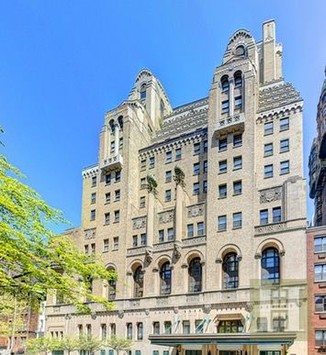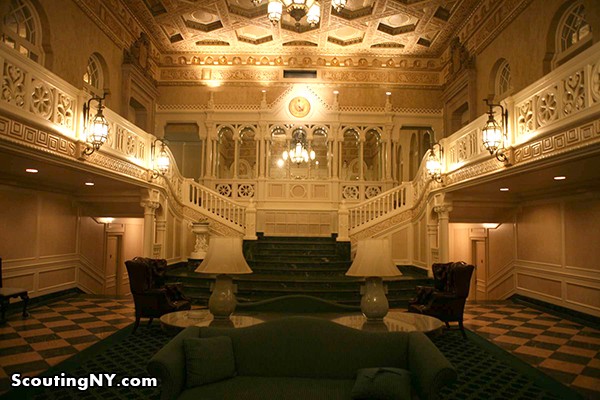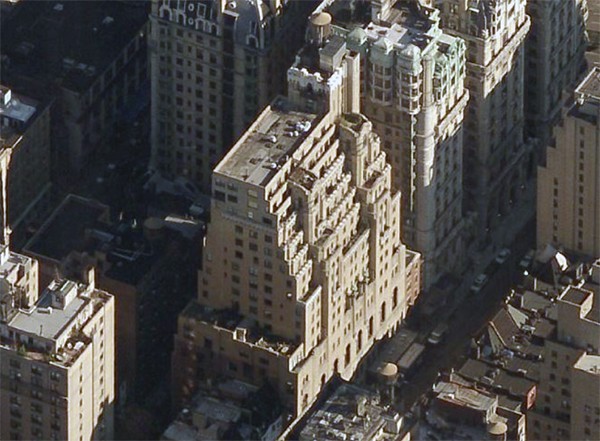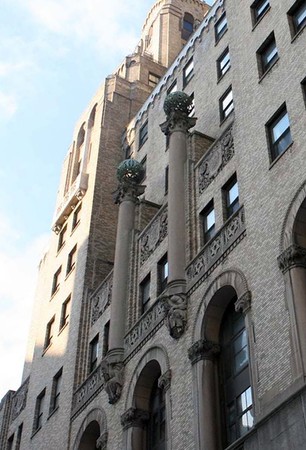The Level Club (1927-1930); Level Club Condominiums
Introduction
Text-to-speech Audio
Although its history is known by few, the Level Club building is one of the city's most unique and intriguing New York landmarks. The building was constructed between 1925 and 1927 for the Levellers, a group within the Freemasons fraternal organization. The remarkable structure, adorned with many of the symbols significant to Freemasons, was designed to replicate Solomon's Temple. The cost of the building placed the Levellers in significant debt, but at that time, confidence was high that the building would help the organization to recruit wealthy and influential members. Instead, the outbreak of the Great Depression led to organization into default. The Levellers disbanded in 1930, and the building was placed on the market. The structure was home to several hotels and was repurposed as luxury condominiums in the 1980s. The building's lobby and exquisite exterior remain, and the landmark structure is listed on the National Register of Historic Places.
Images
The Level Club was designed to mirror aspects of Solomon's Temple

The Level Club's lobby has been restored and preserved. Members of the short-lived organization included Warren G. Harding

An aerial view of the Level Club, designed to look like Solomon's Temple

Close-up view of detailing on the building's facade

Backstory and Context
Text-to-speech Audio
In the early years of the twentieth century, civic-minded New Yorkers formed and joined numerous clubs. In 1919, a group of Freemasons in the city formed a new organization known as the Level Club. The club's founders opened their organization to Masons within the city but eventually decided that it should be open to all Masons nationwide. The members were among the most influential in the city and they decided that the Level Club required a grand building to house their meetings and activities.
The cornerstone of this building was laid in 1925, and the building was completed in 1927. An inaugural ceremony introduced the building and became one of the leading events of the year within a city that was booming. The building was designed with an Olympic sized swimming pool, a 1,500-seat theater, a rooftop garden, over two hundred sleeping rooms for members who could use the club as their personal hotel, and elegant decor throughout the building. The Level Club was built at a time when this part of the city was growing. In addition to providing club rooms and overnight accommodations in this part of the city, it was halfway between the well-known Ansonia Hotel and Charles Schwab's enormous mansion overlooking the Hudson River.
The Levellers only owned the club for a few years. The Great Depression--an economic disaster whose scale was unthinkable in 1927 when the building opened--devastated the city. The club's members were among those hardest hit and the club was not able to continue its payments on the building. The club disbanded and the building went into foreclosure. the building's next owner opened a hotel in this location that opened in 1937.
In the decades that followed, the building has seen many changes, including numerous ownership changes and names. The building once functioned as a kosher hotel and was later home to a drug rehabilitation center known as the Phoenix House. In the 1960s and 1970s, the building's fortunes declined along as real estate developers focused on other parts of the region. But when the Upper West Side once again became a desirable address, investors bought the building for just under $10 million and the Level Club was reborn as luxury condominiums that opened in 1984. It was added to the National Register of Historic Places the same year.
Because of the Level Club's original function as a meeting space for Masons, developers were faced with turning large, open areas into condominiums. The result is a series of oddly-shaped condos with unusual nooks and crannies. Today, the building's unusual features are beloved by residents, many of whom choose to move into other apartments in the building when they become available.
The cornerstone of this building was laid in 1925, and the building was completed in 1927. An inaugural ceremony introduced the building and became one of the leading events of the year within a city that was booming. The building was designed with an Olympic sized swimming pool, a 1,500-seat theater, a rooftop garden, over two hundred sleeping rooms for members who could use the club as their personal hotel, and elegant decor throughout the building. The Level Club was built at a time when this part of the city was growing. In addition to providing club rooms and overnight accommodations in this part of the city, it was halfway between the well-known Ansonia Hotel and Charles Schwab's enormous mansion overlooking the Hudson River.
The Levellers only owned the club for a few years. The Great Depression--an economic disaster whose scale was unthinkable in 1927 when the building opened--devastated the city. The club's members were among those hardest hit and the club was not able to continue its payments on the building. The club disbanded and the building went into foreclosure. the building's next owner opened a hotel in this location that opened in 1937.
In the decades that followed, the building has seen many changes, including numerous ownership changes and names. The building once functioned as a kosher hotel and was later home to a drug rehabilitation center known as the Phoenix House. In the 1960s and 1970s, the building's fortunes declined along as real estate developers focused on other parts of the region. But when the Upper West Side once again became a desirable address, investors bought the building for just under $10 million and the Level Club was reborn as luxury condominiums that opened in 1984. It was added to the National Register of Historic Places the same year.
Because of the Level Club's original function as a meeting space for Masons, developers were faced with turning large, open areas into condominiums. The result is a series of oddly-shaped condos with unusual nooks and crannies. Today, the building's unusual features are beloved by residents, many of whom choose to move into other apartments in the building when they become available.
Sources
Kershaw, Sarah. Big Deal: At the Level Club, "Funky" for Sale. New York Times. September 30, 2011. Accessed July 20, 2019. https://cityroom.blogs.nytimes.com/2011/09/30/big-deal-at-the-level-club-funky-for-sale/.
The Upper West Side's Level Club: Where Residents Don't Want to Leave. New York Daily News. January 25, 2008. Accessed July 20, 2019. https://www.nydailynews.com/life-style/real-estate/upper-west-side-level-club-residents-don-leave-article-1.341619.
The Level Club. Corcoran.com. . Accessed July 20, 2019. https://web.archive.org/web/20110718231626/http://www.corcoran.com/property/levelclub/index.asp?history.asp.
The Upper West Side's Level Club: Where Residents Don't Want to Leave. New York Daily News. January 25, 2008. Accessed July 20, 2019. https://www.nydailynews.com/life-style/real-estate/upper-west-side-level-club-residents-don-leave-article-1.341619.
The Level Club. Corcoran.com. . Accessed July 20, 2019. https://web.archive.org/web/20110718231626/http://www.corcoran.com/property/levelclub/index.asp?history.asp.
